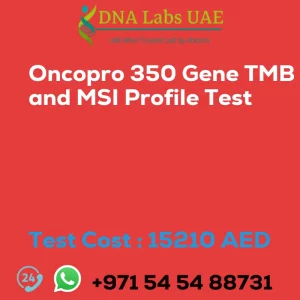IMMUNOHISTOCHEMISTRY P40 Test
Cost: AED 520.0
Symptoms, Diagnosis, and Referring Details
Test Name: IMMUNOHISTOCHEMISTRY P40 Test
Components: P40 Test
Price: 520.0 AED
Sample Condition: Submit tumor tissue in 10% Formal-saline OR Formalin fixed paraffin embedded block. Ship at room temperature. Provide a copy of the Histopathology report, Site of biopsy and Clinical history.
Report Delivery:
- Sample: Daily by 6 pm
- Report Block: 5 days
- Tissue Biopsy: 5 days
- Tissue large complex: 7 days
Method and Test Type
Method: Immunohistochemistry
Test Type: Cancer
Doctor: Oncologist, Pathologist
Test Department: HISTOLOGY
Pre Test Information
Provide a copy of the Histopathology report, Site of biopsy and Clinical history.
Test Details
The P40 test is an immunohistochemistry (IHC) test used to detect the expression of the P40 protein in tissue samples. P40 is a variant of the p63 protein, which is involved in cell cycle regulation and differentiation of epithelial cells.
The P40 test is primarily used in the diagnosis of lung cancer, particularly in distinguishing between squamous cell carcinoma and other types of lung cancer. P40 is highly expressed in squamous cell carcinoma but not in other lung cancer subtypes, making it a useful marker for identifying this specific type of cancer.
During the P40 test, tissue samples are collected and processed for IHC staining. The tissue sections are incubated with a primary antibody specific to P40, which binds to the P40 protein if present. This is followed by incubation with a secondary antibody that is conjugated to a detection system, such as a chromogen or fluorescent dye. The presence of P40 protein is then visualized under a microscope.
The results of the P40 test can help pathologists determine the type of lung cancer present in the tissue sample. Positive staining for P40 indicates the presence of squamous cell carcinoma, while negative staining suggests a different subtype of lung cancer.
Overall, the P40 test is a valuable tool in the diagnosis and classification of lung cancer, helping guide treatment decisions and prognosis for patients.
| Test Name | IMMUNOHISTOCHEMISTRY P40 Test |
|---|---|
| Components | |
| Price | 520.0 AED |
| Sample Condition | Submit tumor tissue in 10% Formal-saline OR Formalin fixed paraffin embedded block. Ship at room temperature. Provide a copy of the Histopathology report, Site of biopsy and Clinical history. |
| Report Delivery | Sample Daily by 6 pm; Report Block: 5 days Tissue Biopsy: 5 days Tissue large complex : 7 days |
| Method | Immunohistochemistry |
| Test type | Cancer |
| Doctor | Oncologist, Pathologist |
| Test Department: | HISTOLOGY |
| Pre Test Information | Provide a copy of the Histopathology report, Site of biopsy and Clinical history. |
| Test Details |
The P40 test is an immunohistochemistry (IHC) test used to detect the expression of the P40 protein in tissue samples. P40 is a variant of the p63 protein, which is involved in cell cycle regulation and differentiation of epithelial cells. The P40 test is primarily used in the diagnosis of lung cancer, particularly in distinguishing between squamous cell carcinoma and other types of lung cancer. P40 is highly expressed in squamous cell carcinoma but not in other lung cancer subtypes, making it a useful marker for identifying this specific type of cancer. During the P40 test, tissue samples are collected and processed for IHC staining. The tissue sections are incubated with a primary antibody specific to P40, which binds to the P40 protein if present. This is followed by incubation with a secondary antibody that is conjugated to a detection system, such as a chromogen or fluorescent dye. The presence of P40 protein is then visualized under a microscope. The results of the P40 test can help pathologists determine the type of lung cancer present in the tissue sample. Positive staining for P40 indicates the presence of squamous cell carcinoma, while negative staining suggests a different subtype of lung cancer. Overall, the P40 test is a valuable tool in the diagnosis and classification of lung cancer, helping guide treatment decisions and prognosis for patients. |








